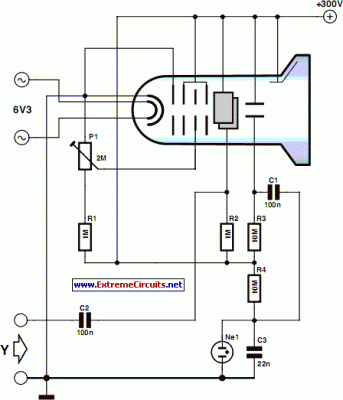- Minimalist Oscilloscope
- Switchable Output Crystal Oscillator
- Simple White Noise Generator
- Triangle / Squarewave Generator
- 1KHz Sinewave Generator
- Reverse Bias Oscillator
- Function Generator
- Oscilloscope testing module (huntron circuit)
- Triangle and Squarewave Generator
- Low Frequency Sinewave Generators
Minimalist Oscilloscope
Circuit diagram:
Description
If you are the proud owner of an old oscilloscope tube, you may be interested in using it once more for its original purpose. All you need are the right voltages on the right pins: in practice you may need to peer closely inside to find out which pins on the base correspond to the acceleration and deflection electrodes, in particular if there is no part number to be seen on the tube. The tube we had for experimental purposes was a 7 cm model of unknown provenance.
So the first step is to establish which pins correspond to the heater, cathode, grids, deflection plates, and anode. With this done we can make our simple oscilloscope as follows: connect the Y input via a suitable capacitor to one of the Y deflection plates; for X deflection we use a neon lamp oscillator to generate a timebase; and with a focus regulator circuit we have a complete oscilloscope.
Operation of the horizontal deflection oscillator is visible as the gentle flickering of the neon lamp. Whenever the voltage across the parallel-connected capacitor reaches the strike voltage of the lamp, it is discharged with a brief pulse of current. It is hard to imagine a simpler way to generate a sawtooth waveform. The supply voltage of 300 V is adequate for simple experiments, even if the tube is rated for operation at 1000 V or even more.
Now, if a signal is applied to the Y input, we should be able to see the waveform on the screen. It must be admitted that the design’s sensitivity, linearity, trace size, bandwidth and triggering facilities leave a little to be desired. Nevertheless we have shown how little circuitry is required to make a real working oscilloscope.
